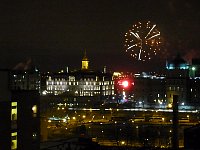
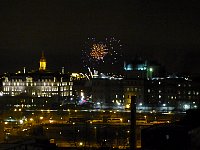
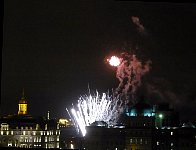
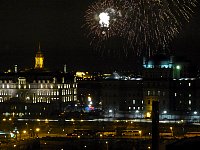
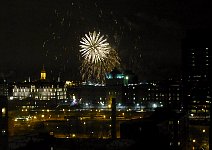
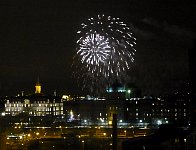
Visiting places outside the main tourist season sometimes works well - you get to see interesting places without the crowds. And sometime you get, essentially, private tours of places, since you're the only one tourist showing up for a tour.
Of course, usually the weather is less than optimal (there is a reasons why it is not the main tourist season, after all), but I don't mind that much.
But sometimes it can also be pretty dull.
This time, it mostly turned out to be the latter.
Though it started quite nicely. When I arrived in Montréal, I had a nice hotel room with a good view over the city. And suddenly there was this noise outside and it turned out that they had fireworks at the old quay every Saturday during wintertime and I had a great view.
I went to the Montréal Science Centre the next day and was also quite impressed by a smartphone based music exhibition.
Usually, I dislike 'multi-media' presentations at museums.
The value of a museum is in presenting an experience that you can't get at home. This is either achieved with presenting original artefacts or by creating environments and experiences that can't easily be duplicated at home.
But clicking on touchscreens and playing videos or audio snippets can be better achieved on the web. I tend to get annoyed if I am in some city, go to the museum, pay for entrance and am then supposed to read through pages of text on a screen - something that I can do more conveniently and at leisure on my computer at home.
So I was a bit derailed in my usual grumblings when they had a multi-media based presentation and it actually was the sensible thing to do and also fairly good.
The exhibition was about music and what they did was to hand out smartphones to visitors and had NFC tags at a lot of places in the exhibit.
Holding the phone to a NFC tag connected the phone with the exhibit.
One advantage was immediately obvious - as every exhibit provided some sort of audio feedback (hard to avoid when presenting music), you could do a fair number of exhibits in a reasonably small room without either having lots of noise or having fixed headphones installed.
Here everyone had headphones connwected to the phones, which made the exhibition appear outwardly quiet and uncluttered.
And some of the presentations were for individual users, but you could also 'share' some exhibits (like the sequencer or the electric guitar) between multiple people all hearing the same.
And you got an incentive to follow at least some of the presentations - at every of the sections, you could choose some parameters of a song (mood, instrumentation, melody snippets...), so at the end you had built 'your song', which could then listened to at the end by other visitors.
So they made good use of a multi-media presentation at the museum and actually did provide an experience that would be difficult to experience (in its entirety) at home. And an added value for Montréal was that you didn't need to go through a French/English selection screen more than once.
Leaving the museum, I was a bit surprised by seeing a jumble of buildings on the other side of the river. I had seen that on websites showing 'unusual buildings', but I hadn't been aware that 'Habitat 67' was located in Montréal. While essentially a neat idea, the place looks somewhat run down - someone looking at the pictures asked "They have slums in Montréal?"
And having it mirrored by this ugly block of a building on the other side of the river doesn't really help.
Originally built for grain processing and distribution, it has now been acquired by some development company, which is currently doing nothing with it. Well, according to its web page, it "continues to study many options and possibilities as part of its planning process" and has done so for two years now...
Although something might happen with it in a decade or two - it might become the Montréal equivalent of the Tate Gallery some day.
Later, I walked around a bit in the city and up to Mont Royal, which, in theory, offers a great view over Montréal, but since the weather was kind of dodgy, the view was somewhat restricted.
Luckily, next morning the view (from my hotel room) turned out to be a bit better.
One nice thing about Montréal is that there are some events going on in December to make it less dull. One of these are the weekly fireworks, but they also had an art installation that (in an abstract way) represented an iceberg calving off a glacier and slowly melting. Basically there were a series of segments of steel ribcages that got increasingly smaller and most of them were 'interactive' in some way, so the first set made crackling noises that followed you when you passed under a 'rib', while the second one changed the colour of the individual ribs, and so on.
Though I didn't want to spend the whole time in Montréal, but wanted to do more stuff outdoors.
And I had a plan.
Which didn't work.
The plan was to find a company that did ATV/quad and snowmobile tours. So, if winter started early, I could do a snowmobile tour, but if it was still autumn weather, I'd be at least able to do an ATV tour. One way or another, I would be on some tour.
So I called on Friday, made a reservation for Sunday, added another day in the area, just to be on the safe side and drove to the Algonquin Park area in Ontario on Saturday.
It was about five hours of driving and during the last hour it started to snow. And later that evening I got an e-mail from the tour organizers that they just came back from the pub and there was a fair amount of snow at it was very slippery. As the trail goes along steep inclines and there would be the risk of going over the edge in slippery conditions, they were cancelling the tour. (There wasn't yet enough snow for a snowmobile tour either.)
So I suddenly found myself in (pretty much) the middle of not very much (a place called Barry's Bay) with two days of nothing to do. (And any hopes of having the tour on the second day were dashed when the weather report correctly predicted freezing rain for that day.)
But at least I was close to Algonquin Park.
It wasn't quite clear what could be done in Algonquin Provincial Park - the 'main attraction' there is canoeing, which clearly wasn't an option at this time of year. And 'winter activities' such as cross-country skiing (which was kind of limited anyway) were not available yet.
But at most of the walking trails were still open. So I picked up a couple of guide books for various trails (Beaver Pond Trail, Hemlock Bluff Trail, Bat Lake Trail, Two Rivers Trail, Algonquin Logging Museum Trail) at the entrance gate and got started.
At least I got fairly lucky with that. The weather in the morning was great and there was a light layer of snow on the trail, so it was possible to walk the trails at normal speed and still have the 'winter wonderland' feeling.
And, since it was essentially the wrong kind of season for anything, I had the trails to myself (all together I saw only four other cars parked at trailheads).
As I mentioned in the beginning, "sometime you get, essentially, private tours of places" and while this wasn't the quad or snowmobile tour I had hoped for, I had the trails that interested me all to myself.
And even though the weather became a bit murkier in the afternoon, it was still good to be outside, the trails were fun to walk on and I managed to do all the trails I bought the guide books for.
There weren't any beavers to be seen at the Beaver Pond Trail, but at least their works were clearly visible.
The only wildlife I spotted was some kind of otter or weasel.
Which I re-spotted later from a viewpoint across the lake. (The small black dot on the ice, slightly to the left of the center of the second picture.)
By then I was getting a bit tired and sunset wasn't that far away either, so I finished the Beaver Pond Trail and went on the last trail, the Algonquin Logging Museum Trail, which has various outdoor exhibits about logging in the park - past and present, since even though it is nominally a National Historic Site, there is still significant logging going on in large areas of the park.
At the entrance of the trail I did see another animal, but I wouldn't really call that wildlife - more semi-domesticated. At least it was well (self-)trained in sitting on the fence, looking cute and hoping for visitor hand-outs.
There was a surprising amount of stuff along the Algonquin Logging Museum Trail. I had expected a couple of info tables, but there were full size buildings, dioramas, boats, trucks and locomotives along the way. (Including some plastic horses being wrapped up for the winter, which looked a bit surreal.)
I finished the trail around sunset and drove back to Barry's Bay. As the weather the next day was a bit unpleasant, I spend most of they day watching daytime TV - not a fun experience.
Luckily the next day the weather was much better again and I drove to Ottawa on a slightly random route, skipping the main roads and sticking to smaller backcountry roads.
As there wasn't any chance of significant outdoor activity, I decided to stay the rest of the week in Ottawa - at least there were museums and shops to spend some time in.
And the Canada Aviation and Space Museum was surprisingly good. It has lots of original artefacts (mostly airplanes, obviously, but occasionally cars or motorbikes were added for ambience) and quite a few of them with a wide variety of designs.
Most modern aircraft look kind of similar, but it's sometimes fun to look at old planes to see ideas or designs that probably seemed like a good idea at the time, but didn't lead anywhere, like the Shorthorn, which now looks a bit like it was assembled the wrong way round, with the propeller behind the pilot.
Even the suspension looks strange - instead of having springs or hydraulics, they basically tied rubber strips around the axle.
Or the Curtiss Seagull, also with a propeller behind the pilot and an engine that looks like it has been designed by an air conditioning manufacturer. (The plane is a replica; the original bit is the black thing on the floor next to it - to the left of it.
I also hadn't been aware that A.E.G. in Germany had once built airplanes (back in 1918) and that it had a fairly ridiculous camouflage pattern. It's almost impossible to see on the picture (maybe a bit can be concerned on the horizontal stabilizer / elevator) and it's even hard to see when you are standing next to it in a well lit museum. Basically it's a foliage pattern in three shades of dark black.
So why do all the effort of paint a camouflage pattern that is difficult to distinguish from just a simple coat of black paint? (Unfortunately there's no explanation for this in the museum. Maybe there was just a regulation that all planes had to be painted in camouflage pattern and someone just didn't want to spoil the look of it. Maybe it was a bit like playing "Need for Speed: Underground" where you needed to buy 'visual upgrades' to your car and the only way to keep your car from looking like some advertising board on wheels was to take a black car and apply only black stickers to it.)
And while there's usually not much to do in aircraft museums (after all, the prime attractions are the airplanes), they put in a reasonable effort to give visitors something more 'hands on', like a small flight simulator or two open cockpits (one Snowbirds’ Tutor CT-114 and one MIG) that you can sit in. (And you get a lot of information about those two cockpits, since the museum guide next to it seemed near desperate to find people to talk to...)
Also, the museum does not house the full collection of airplanes, but there is also the reserve hangar next door with even more planes. (Unfortunately I didn't notice that the reserve hangar was accessible with guided tours twice a day, so I only got to stand outside and look through the windows at the planes.)
And, even better (in principle), the museum is next to a small airport, so they offer helicopter rides and biplane rides (in a Waco UPF-7) right beside the museum. But, again, this was the wrong season to actually do this, since they only do these flights from spring to fall. (And even though I have to admit that I can see the point of that and that flying in an open cockpit plane at sub-freezing temperatures might not be a good idea, I probably would have given it a try anyway, just to find out...)
I also visited a number of other museums in Ottawa. (Nothing much else to do...)
Worth a visit was the Royal Canadian Mint. This is one of the cases where 'off season' turned out to be convenient, since I was the only visitor on this particular tour, so the tour turned more into a informative walking chat with the tour guide than a formal tour.
While they don't actually make the money for Canada (that facility is in Winnipeg), they handle all commemorative and 'investment' coins, which include a lot more handling of the coins. So the tour is not all "and here's a big machine where we can't see anything, but what it does is...", but most parts of the coin making can actually be seen.
And I'm not sure whether this is intentional, but when I bought the ticket, I got the change in shiny new coins. Since they don't do the circulation money in Ottawa, there is no reason why this should be the case - they might get their cash from the bank like everyone else - so this might have been just a coincidence. But maybe someone actually puts in the effort to make sure that the money you get from the Mint is mint, which would be neat.
Another museum worth visiting (even if just for a single piece of information) was the Ottawa Currency Museum. While just looking at money in various forms) isn't overly exciting, there were a number of oddities, like the Hudson Bay Company coins, which did not represent dollars and cents, but directly corresponded to beaver or fox pelts.
Thought the one thing that took me by surprise was the long history of competition among the various banks and their individual currencies. Seeing money now as something issued by the state (well, usually a bank, like the Bank of Canada, but owned by the state), it looks strange to see old bank note from competitive private banks. (With the effect that people started fraudulent banks that just produced their own notes, hoping that they would be accepted as legal tender among the currency from a couple of dozen more legitimate banks.)
I shouldn't have been surprised - after all the things are called 'bank notes' for a reason - but I had never paid attention to the history of paper money.
Something unexpectedly familiar was the spider in front of the National Gallery of Canada.
I had seen the sculpture in Bilbao years ago and I had spotted that in Geneva and London as well. And now it turned up in Ottawa.
It seems like this sculpture (Maman by Louise Bourgeois) is turning into an entrance marker for modern art galleries and museums. Wikipedia currently lists eight permanent installations and seventeen temporary ones. I'm not quite sure why, but it seems that it now has the function that Henry Moore sculptures had in the 1960's and 1970's.
A rather disappointing museum was the Canada Science and Technology Museum
The whole collection seems kind of confused and random. And more 'proud Canadian' than science or technology.
For example, they had the "Innovation Canada" exhibit (and the Canadian Science and Engineering Hall of Fame) that showed scientists from Canada and what they had developed. And the exhibits included a snowmobile, an electron microscope, a goalie mask, a deep sea vehicle and an artificial heart. All fairly arbitrary and with very little background information except for all being 'Canadian'.
It's also quite questionable in making things 'Canadian'. For example, the artificial heart is specifically the HeartSaver artificial heart, which, as far as I can tell, never made it past prototypes and animal testing about 20 years ago. It was neither the first attempt at such a device, nor a successful one. It has been built in Canada, though.
Nearby was a presentation of various cars under the heading "In Search of the Canadian Car" with an interactive voting panel for the most "Canadian" car. It included a choice of categories that included "Marketed to Canadians" and "Chosen by Canadians", so it could include cars like a Volvo (admittedly built in Canada for some time) or the Volkswagen Beetle, which, when I was at the museum, was leading the poll as the most "Canadian" car.
Besides being kind of odd with putting on a "Canadian" theme on the car exhibits at all, the whole idea of voting according to personal tastes in a science museum felt weird.
Other exhibitions seemed fairly neglected. While it is a museum and some old stuff should be expected, the original objects should be old, not the presentations.
There was one presentation on satellite telephones and satellite communication which ended with possible things to come in the future. Of 199?. It shows a small (for that time) satellite receiver for text messages with the byline "Earth stations like this, forecast for the future, would let you be in contact with anyone, anywhere anytime. Would you want one?"
Modern satellite phones are still expensive (about three times the cost of a smartphone), they have been around for some time and while costly, are affordable and available to everyone. So having an exhibit with an outdated device and talking about the far future of sometime in the 1990's seems like someone made an effort with the exhibition about twenty years ago and since then only dusted it from time to time.
And the 'live science presentation' was of similar quality.
One of the presentations consisted of two large softdrink bottles connected at the openings, filled with about one bottle worth of water.
Probably everyone knows the idea behind that - you let the water run from one bottle to the other, measure the time and then show how the water empties much faster when you give the bottles a swirl and an air vortex forms in the middle.
And that was exactly like it was presented (badly) - essentially as a knowledge question.
So the presenter let a bit of the water run from one bottle to the next, mentioned that this was pretty slow and asked the audience how the water could be made to sun faster. After getting the desired answer, he swirled the bottles, mentioned that this would be much faster now and went to the next demonstration.
One of the problems with this was the absence of any measurement. He didn't even let half of the water run from one bottle to the next before noting how slow it was and asking for ways to improve the speed. And while waiting for answers, he turned the bottles upside down and let the water that had gone down so far float back.
So there wasn't any baseline measurement or even a chance for someone in the audience to mentally make one, since only an arbitrary amount of water was drained instead of all of it.
Also, the good thing about this experiment is that the result is unexpected if you have never seen that before. Asking around until someone gives the right answer promotes previous knowledge, not scientific interest.
It would have been much better to just show the experiment (and do measurements - the way it was presented the version with the swirl didn't seem much faster than the original one). And then see what can be done in further experiments.
For example, how much is the swirling of the fluid (which obviously makes it move faster) a relevant factor and how much the air flow? This could easily be tested with a long straw going through the bottles, allowing to create air flow without swirling the bottles. Is the speed close to the swirled version? Or closer to the original speed?
And is critical issue in slowing down the flow (without vortex or straw) the vacuum above the fluid in the upper bottle or the air in the lower bottle? What happens if we fill in water (without swirling) from an (at the top) open container? Where does this end up on the scale of flowing times? And the other way round - how about not having to work against the air pressure in the lower bottle? Simply measured by just using one bottle and emptying it into a sink. So what has more effect? The vacuum in the upper bottle or the air in the lower one? And if we take the original experiment - do both times sum up when both bottles are involved? Or how are they combined.
And is there a 'sweet spot' as far as the air tube size is concerned? Is it sufficient to swirl enough so that there is just any small air tube or does the water flow even faster if it is swirled with sufficient strength to get a very big air tube? (Obviously, but interesting to demonstrate, if the swirl is too strong, we just get water pressed against the walls of the bottle and not flowing down at all.)
For more accurate measurements, there could be more non-swirling experiments with straws of different diameters. I would assume that a fairly small air tube would be the most efficient option, since air is compressible and water isn't. But is that actually the case? And if it is, is it really because air can be easily compressed or is this a question of weights? What if I have two fluids in the bottles, a high and a low density one?
And so on. There's tons of scientific stuff that could be done based on the simple bottle swirl experiment. But handling this as a sort of quiz question with only a suggestion that the water is now running faster made the presentation more look like the 'scientific proof' on some TV advertisement programme than anything that belongs into a science museum.
But then, maybe the presentation was also developed about 20 years ago and has been repeated unthinkingly ever since.
While the twirl bottle experiment was probably the worst offender, a lot of other remarks were sufficiently awkward to make me cringe. Not exactly wrong, but misleading in cases where it could have been much more interesting not to simplify.
For example, they had a Van de Graaff generator and then invited kids to stand on an isolated platform and be charged, so that the hairs stand up. Always a fun presentation and also a good one, since it's one of the things that are difficult to do at home, so going to a museum and do something 'special' makes it more memorable.
So far, so good. But the presentation went along the lines "you get electrically positively charged and this is like magnetism, where identical poles repulse each other, so the hairs are repulsed from each other here".
Which is not really wrong, but annoyingly misleading.
Because electrostatic charges are pretty much not like magnets at all, except for some 'repulsion' effect. Most importantly, you can be positively charged, but you don't have magnetic monopoles. So, if you take a bunch of small magnets and throw them in a heap, you won't get some spiky looking form, but just a fairly tight cluster of magnets.
Unless, of course, you take a look at ferrofluids, which actually do form 'spikes' in the presence of a magnetic field. (Although the reason why this happens is slightly complicated.) Showing some ferrofluid would also be interesting and lead to other demonstrations. But explaining electrostatics with magnetism just leads nowhere and doesn't really explain anything.
Well, time to go outside and just walk through Ottawa instead, having a look at the Rideau Falls, the parliament buildings in the haze and a couple of sculpture next to the Rideau Canal.
After three days of shops and museums, it was time to get a bit outside again. Gatineau Park isn't far away and while the web page was a bit vague on the current possibilities, it was close enough to just give it a try.
(In winter, hiking is fairly limited in the park - most trails are converted to cross-country skiing or snowshoeing tracks and only three fairly short hiking trails remain. And while it was clear that there wasn't any cross-country skiing or snowshoeing yet, and the winter hiking trails were fairly distant from each other and would require a lot of driving to get from one to the other, especially since the parkways within the park definitely were already closed for the season. So, from the web site, it wasn't clear what could be done at all.)
Once in the park the situation was better than expected and the visitor center was very helpful. It turned out that the parkways were closed for cars, but the park distinguishes between parkways and chaussees. And the chaussees were open (and seem to stay open all winter). Also, since the hiking trails couldn't be converted to cross-country skiing yet, all of them were still open.
So I stated my interest (about 10-15 km of easy to moderate hiking, preferably a loop trail, aiming for two to three hours) and they suggested a trail, started to describe how to drive to the trailhead, reconsidered and recommended another trail that I could walk from the visitor center to the trailhead and both trails together were pretty much what I had been looking for.
And, similar to Algonquin Park, the day started out nice and sunny, so it was a fairly pleasant walk in the woods.
Next day, it was already time to head home again. I had a late flight from Montreal, so instead of taking the highway, I drove along the north shore of the Ottawa River, trying to avoid the main streets and stay as close to the river as possible.